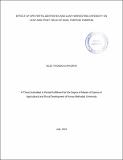| dc.description.abstract | Pumpkin (Cucurbita maxima) is a dual purpose vegetable in the family Cucurbitaceae. It is grown for its fruits and leaves which are a source of nutrition and income. This has led to high demand of this plant hence need of proper cultural management to achieve high yields. There is, however, no documentation of cultural practices that can help optimize both vegetable and fruit yield of the dual purpose pumpkin. This research was aimed at determining the optimal leaf harvesting intensity (LHI) and Nitrogen, Phosphorus, Potassium (NPK) rates that lead to achievement of high leaf and fruit yields. The leaf harvesting intensity was done at 4 different levels: Zero leaf, one, two and three leaves harvested per week per branch. NPK (17:17:17) fertilizer also applied at 4 levels: 0 kg/ha-1, 100 kg/ha-1, 150 kg/ha-1 and 200 kg/ha-1. The experimental design used was a Randomized Complete Block Design (RCBD) with 3 replications. The variables assessed are leaf yield, and fruit yield. Leaf harvesting commenced when the plant had 15 leaves and continued on a weekly basis. Parameters measured include number of seed and 100 seed weight, number and weight of fruits. Data obtained was subjected to analysis of variance, SPSS and means of significant treatments subjected to mean separation using least significance difference at α ≤ 0.05. ANOVA showed that there are significant differences for fertilizer rates and number of leaves picked. (p<0.05). Fruit and leaf yield of pumpkin was the highest at 150 kg/ha-1, the number and weight of seed were higher at this rate than other NPK levels. Therefore, I recommend that 150 kg/ha-1 NPK fertilizer rate is the optimum NPK level for C. pepo and leaf harvesting intensity of 1, 2, or 3 leaves per week did not have any significant difference and this means that families who use the leaves as vegetables can pluck three leaves per week without significantly affecting the rate of photosynthesis at the location where this experiment was conducted. | en_US |

